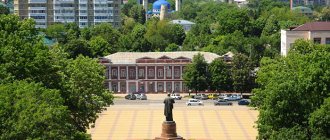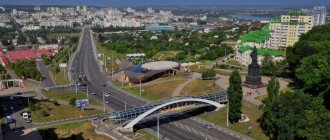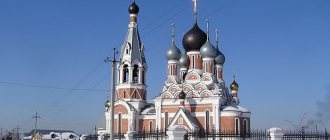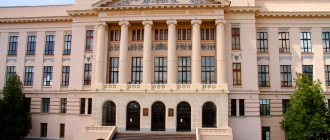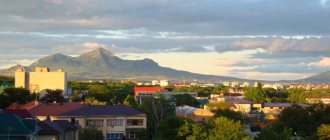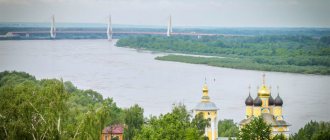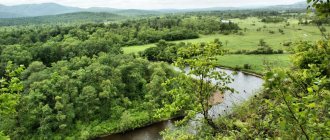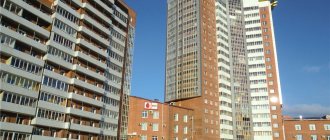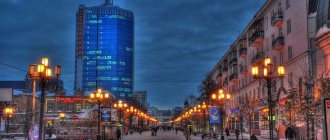- September 20, 2019
- Directions
- Molton
Kazan is a city on the European territory of the country, the capital of the Republic of Tatarstan. This is a large port city. Where is Kazan? This historical and cultural center is located on the left bank of the Volga River, in the area where the Kazanka River flows into it. One of the most successful cities in Russia, a major scientific, educational, cultural, economic, religious and sports center. The city has a long history, dating back over 1000 years. In the past it was the capital of the Kazan Khanate. Kazan is called the “third capital of Russia”.
Kazan gained the greatest fame as a city that has repeatedly hosted international sporting events in various sports. In 2021, a number of matches were held here as part of the FIFA World Cup.
Kazan is an important tourist center. According to this indicator, it ranks 3rd in Europe and 8th in the world. The city is also very popular among Russian tourists.
Kazan is a millionaire city. The number of inhabitants is approximately 1 million 250 thousand people. It is divided into 7 districts. City Day is celebrated on August 30.
Kazan city (Russia)
Kazan is one of the oldest cities in Russia, located in the Middle Volga on the Kazanka River. It is the capital of the Republic of Tatarstan and the largest city in the Volga region. Kazan is one of the most beautiful and interesting places in Russia, a city with a magnificent historical and cultural heritage. The most famous landmark of the capital of Tatarstan is the Kremlin, which is included in the list of UNESCO World Heritage Sites.
Kazan has a thousand-year history and is often called the “third capital of Russia”. Since ancient times, the city has been a kind of bridge between East and West, which has had an interesting effect on its architecture, culture and even atmosphere. Here, Christian churches coexist with Muslim mosques, magnificent ancient palaces with modern buildings, giving the capital of Tatarstan an amazing flavor.
Location
If you wonder where the city of Kazan is located on the map, it is more convenient to use the “2 GIS” service or a map in any Internet search engine. The metropolis is located in the central part of the Russian Federation. The city is divided by the Kazanka River, which flows into the wide “artery” of the state, the Volga.
Kazan is separated from the capital of Russia by a route 820 km long in an eastern direction. The city shares the same time zone with Moscow. Kazan annually attracts a huge number of tourists from different parts of the world.
Might be interesting:
Saint Petersburg
Moscow
Velikiy Novgorod
Krasnodar
all cities
Kazan in the 19th–20th centuries
The history of Kazan in the 19th century is associated with the opening of a number of educational institutions at the national level and with significant discoveries in the field of science.
In 1804, Kazan University was opened. It became 3rd in the entire empire in terms of importance and time of foundation. For a long period, the university was also the most eastern in the country. In 1844, Karl Klaus, a professor at the local university, discovered the chemical. element ruthenium. He was christened in honor of the empire.
In 1841, an institute for noble maidens began its activities here, and in 1858, a women’s school with a spiritual focus.
In the mid-19th century, a School for blind children appeared here. Today this premises houses the second municipal infectious diseases hospital.
In 1859, municipal authorities opened the Mariinsky First Kazan Women's Gymnasium in Kazan. The educational institution received the level of a first-class school.
1874 marked the beginning of the work of the local Veterinary Institute, which became famous for its scientific experiments.
In 1875, a Real School was founded here, and in 1905, a Commercial School was founded. Those who graduated from a real school could go on to study exclusively at a polytechnic university. Since 1901, Kazan has had its own observatory.
In 1890, another educational institution of a technical nature arose in Kazan - the Chemical-Technological School. The most famous graduate of the school was Sergei Mironovich Kirov. The future revolutionary was an orphan, so one of the charitable societies paid for his education. After the October Revolution, in 1919, KPI - Kazan Polytechnic Institute was created on the basis of the school.
In the 20th century, the city withstood considerable trials. Kazan “gave birth” to more than one revolutionary. On March 2, 1917, the local council of soldiers' and workers' deputies became the main elected body of Kazan. The new government “dismantled” the position of governor - a specially appointed red commissioner began to perform his duties.
In 1918, the white and red armies fought not only for the settlement itself, but also for the gold of the empire, which ended up in the city and then disappeared without a trace.
May 27, 1920 is the date of the emergence of the Tatar Autonomous Soviet Socialist Republic. The main city of the newly created territorial entity is the city of Kazan. The 30s of the 20th century were marked by a rapid industrial revolution. The population of Kazan increased sharply, and the metropolis itself expanded north of Kazanka.
During the Great Patriotic War, a large number of enterprises were transferred to the city, and the scientific elite of the state was evacuated. Before the Great Victory, there was the USSR Academy of Sciences, Design Bureaus and various research institutes.
The active growth of the settlement continued in peacetime. So, in 1979 the number of inhabitants exceeded 1 million people. Surrounding villages were added to Kazan, in particular Yudino and Derbyshki. The layout of the metropolis has practically become radial-circular. Two very large residential areas have emerged in Kazan: Novoye Savinovo and Gorki.
Kazan received the status of one of the largest river ports in the country, and a new airfield was built here.
Geography and climate
Kazan is located in the east of the European part of Russia, 800 km from Moscow. The capital of Tatarstan was built on the left bank of the Volga at the confluence of the Kazanka River, which divides the city into two parts: the southern historical part and the more modern northern part. The relief of Kazan is predominantly flat with low hills.
The climate of the city is temperate continental. It is characterized by relatively cold and snowy winters, as well as warm, slightly rainy summers. The best time to visit the capital of Tatarstan is from May to September.
Panorama of Kazan
Climate in different seasons
The weather in Kazan is stable. Summers are usually moderately hot, with temperatures up to 26 degrees. During the week, the heat is replaced by rain, alternating with the heat. Summer weather is always comfortable, even when it rains.
The only surprise, as throughout Russia, was presented by nature in the summer of 2021, when at the end of July the weather deteriorated sharply and lasted until mid-August with abnormally low temperatures of 9-14 degrees.
Many tourists are interested in what winter is like in the capital of Tatarstan? Winter in Kazan requires warm clothes. Frost bites, “delighting” with temperatures down to -28 degrees. In general, winter temperatures do not exceed -23.
Spring, like this season in other areas of the Volga region, is characterized by cool winds and capricious weather throughout the week. It is especially cold in early May. People say “when the bird cherry blossoms”, expect cold weather, and the residents have long been accustomed to this. What attracts Kazan?
Story
The history of Kazan goes back more than a thousand years. Scientists believe that the settlement on the site of the modern city was founded around 1005. Initially, a fortress was built here on the northern border of Volga Bulgaria. In the 13th and 14th centuries, Kazan became an important center of the Golden Horde.
In 1391 the city was first mentioned in chronicles. In 1438, Kazan was captured by Khan Ulu-Mukhamed and became the capital of the Kazan Khanate. Over the next hundred years, the Khanate repeatedly fought with the Principality of Moscow and, ultimately, in 1552, Kazan was taken by Ivan the Terrible.
Kazan Kremlin
In 1556, construction of the Kremlin began here. By the 17th century, Kazan had become one of the most important cities in Russia, and at the beginning of the 18th century it became the capital of the Kazan province. A university was founded here in 1804.
The magic of the third capital
The metropolis is often called the third capital and for good reason. Different peoples besides the indigenous Tatars coexist harmoniously in it. The Udmurts, Chuvash, Russians and other cultures settled here long ago, bringing their own “zest” of life and traditions. The national flavor, diluted with the bright harmony of a mixture of cultures, attracts tourists who want to unravel it.
Kazan is a rich region that reflects life in all regions of Tatarstan. Oil outlets allow the republic to set affordable prices in stores and stably develop the economy. A lot has been built for the convenience and comfort of the population and travelers for the 2013 Universiade.
In particular, new suburban railway and air terminals appeared, and the station for long-distance trains was updated. This region of Russia is full of cultural and historical heritage sites that are worth coming here for.
The developed infrastructure with an abundance of shopping malls, business centers, and universities is complemented by a convenient transport interchange connecting the city with Mari El and the cities of the Volga region.
From the central bus station, located near the River Port, buses depart throughout Russia and to neighboring countries. What is important for a traveler to know about climate conditions when planning a trip?
How to get there
Kazan has a large international airport located 26 km south of the city. The capital of Tatarstan has regular air connections with most major cities in Russia, as well as cities in Turkey, Bulgaria, Greece, the UAE, and Thailand. In addition, Kazan is a major railway and transport hub. By car from Moscow you can get here via the M7 motorway.
Public transport in Kazan is represented by one metro line, numerous bus routes, tram and trolleybus lines. The Kazan metro includes only 10 stations. There are five tram routes.
Kazan as part of the Russian state
Thus, after 1552, a new history of the city of Kazan begins, now in the Muscovite kingdom, and later in the Russian Empire and the USSR.
By order of Ivan IV, the construction of the white-stone Kremlin begins here. The ruler of Muscovy initiates a whole resettlement: handicraftsmen, traders, commoners, as well as nobles who fell into disgrace with the tsar were transferred here from other Russian settlements.
In 1708, the settlement became the main city of a large province. During the time of Peter the Great, a cloth factory and a leather factory were built here, as well as an admiralty that produced various types of ships. In 1722, the emperor himself came here.
In the 18th century, wooden pavements appeared in Kazan, and bridges were built across local rivers. On May 3, 1749, a huge emergency occurred in the history of Kazan: the Staro-Tatarskaya Sloboda, as well as other areas, suffered due to a powerful fire. Then Luka Konashevich, the local bishop, tried to drive the Tatars out of their area. To do this, he began to build a seminary in the settlement.
The Tatars moved from the territories adjacent to the seminary. This gave rise to a new district of the city - Novo-Tatarskaya Sloboda. Later, Bishop Luke suffered from his own decision: Empress Elizaveta Petrovna transferred him to Belgorod.
In 1766, a reform of local government took place: the municipal duma began to govern the city. Tsarina Catherine II issued largely liberal decrees regarding the city. Thus, she abolished the restrictions in force before her on the construction of national public buildings and mosques made of stone, and issued a decree “On Tolerance of Religions.” Thanks to this, in Kazan she is still called the queen-grandmother.
In 1774, the uprising of Emelyan Pugachev began, which directly affected the city. Rebel troops entered Kazan. Only the Kremlin remained under the control of government troops. However, after a severe fire broke out in Kazan, Pugachev had to give the order to the soldiers to leave the city. Three days later, his troops were defeated on the Arsk field.
In the 18th and 19th centuries, Kazan changed rapidly. Appears here:
- Tatar Town Hall (1781);
- his own theater (1791);
- omnibuses, there were almost none in Russia at that time (1854);
- gas lighting (1874);
- lighting by electricity (1897);
- tram (1899);
- telegraph (1859);
- telephone (1881);
- water supply (1874).
Attractions
The Kazan Kremlin is the oldest part of the city and the most famous landmark of Kazan. It is a magnificent ensemble of historical, architectural and cultural monuments, surrounded by white stone walls. The origins of the Kazan Kremlin go back to the beginning of the 11th century, when a border Bulgarian fortress was built on this site. It acquired its current appearance in the 16th and 17th centuries, preserving several fragments from past periods.
The Kremlin in Kazan was built in the traditional Russian style by Pskov craftsmen, so its walls resemble a similar fortress in Pskov.
Kazan Kremlin
The Kremlin is located on the left bank of the Kazanka River on a hill. Its area is 15 hectares. The walls are 1.8 km long and reach 12 m in height. Eight towers and two gates have survived to this day.
The main attractions of the Kazan Kremlin
Syuyumbike
Syuyumbike is a high 58-meter brick watchtower, which is one of the architectural dominants of the Kremlin. Its exact date of construction is unknown. The first written mentions date back to 1777. The tower has a passage gate and is topped with a spire. Interestingly, Syuyumbike is a “leaning tower”. The deviation from the axis is about 2 m.
Kul Sharif
Kul-Sharif is the main mosque of Tatarstan, the construction of which was completed in 2005. Erected on the site of the historical mosque of the Crimean Khanate, destroyed during the capture of Kazan by the troops of Ivan the Terrible. Kul Sharif is built of granite and marble, has six minarets (four large and two small) and one dome.
Blagoveshchensky cathedral
The Annunciation Cathedral is the main Christian temple in Kazan and the oldest surviving monument of the Kremlin. It was built between 1555 and 1562 on the site of a wooden church, erected immediately after the capture of the capital of the Kazan Khanate. The cathedral was built by Pskov craftsmen and is a magnificent example of late medieval Russian architecture. In the 17th century, a high 50-meter bell tower was added to the church, but it was destroyed in 1928.
Spasskaya Tower
The Spasskaya Tower is the main tower of the Kazan Kremlin, built in the 16th century and has a height of almost 47 meters. It has four tiers and is built of white limestone. In the past, next to the tower there was a beautiful chapel, destroyed during Soviet times.
Taynitskaya Tower
The Tainitskaya Tower was built in the mid-16th century on the site of a hidden water source. During the time of the Kazan Khanate, the Nur Ali Tower was located on this site, through which Ivan the Terrible entered Kazan.
Southwest Tower
The South-West Tower is the same age as the Spasskaya Tower and was also built by Pskov craftsmen.
Presidential palace
The Presidential Palace is a beautiful historical building from the mid-19th century, built in the neo-Renaissance style (Russian-Byzantine style). The palace was once the residence of governors. During the time of the Kazan Khanate, the Khan's palace was located on this site.
Cannon Yard
The Cannon Yard is an ensemble of historical buildings from the 17th to 19th centuries in the Baroque and Classical styles. The complex was one of the largest places for the production and repair of artillery pieces in the Russian Empire and functioned until the mid-19th century.
Kremlin embankment
Kremlin Embankment is a colorful pedestrian street that begins at the walls of the Kremlin. It is one of the most popular places among residents and guests of the city for a walk. The embankment acquired its current appearance in 2013 - 2015.
Other sights of Kazan
Bauman Street is the central street of the historical center of Kazan, which begins at the Kremlin walls and stretches to Tukay Square. A huge number of architectural and cultural monuments are concentrated in its vicinity. This is also one of the oldest streets in Kazan. During the time of the Kazan Khanate, the Nogai tract ran here.
Bell tower of the Epiphany Cathedral
The Epiphany Cathedral was completely completed in 1756 and is located on Bauman Street in the depths of the courtyard. The temple was built in the Russian Baroque style and before the revolution had a richly decorated interior. What stands out in its architecture is the tall brick bell tower in the neo-Russian style, which for a long time was the tallest building in the historical center of Kazan.
Temple of all religions
The Temple of All Religions is a relatively modern architectural complex, built in 1994 and dedicated to all religions of the world. This colorful ensemble includes a Christian church, a Muslim mosque, a Jewish synagogue and a Buddhist pagoda.
Al-Marjani Mosque in Staro-Tatarskaya Sloboda
Staro-Tatarskaya Sloboda is a colorful historical district of Kazan, located between Lake Nizhny Kaban and the Bulak Canal. Its heart is Yunusovskaya Square. This part of Kazan is the historical center of the Tatar community (after the conquest of the city by Ivan Vasilyevich) and is a unique architectural ensemble of ancient buildings, palaces and mosques. Staro-Tatarskaya Sloboda is a great place to experience the culture of Tatarstan and see traditional Tatar architecture.
There are several ancient mosques in this area, among which al-Marjani stands out. This is one of the oldest mosques in Kazan, founded in the second half of the 18th century and for more than two centuries it has been the cathedral mosque of Tatarstan. Al-Marjani was built in the traditional Tatar style, has one minaret and predominantly Baroque architecture.
Tikhvin Temple
Tikhvin Church is one of the oldest churches in Kazan, located in the Staro-Tatarskaya Sloboda. The temple was founded at the end of the 17th century and rebuilt in neo-Russian style at the end of the 19th century.
Zilantov Monastery
The Zilantov (Uspensky) Monastery was founded in 1552 by Ivan the Terrible and is located approximately 5 km from the Kazan Kremlin on the hill of the same name. This hill plays a big role in the folklore of Kazan. According to legend, the winged serpent Zilant lived at its peak, which is now one of the symbols of the capital of Tatarstan.
The architectural ensemble of the monastery was formed in the 17th and 18th centuries and included several churches, a school and a seminary. During Soviet times, the monastery was closed, and its ancient buildings were practically destroyed. The All Saints Church of the 17th century has survived to this day, and relatively recently (in 2006) the Trinity Cathedral was erected.
Alexandrovsky Passage
Alexandrovsky Passage is one of the most striking buildings in Kazan in the style of eclectic architecture (modern and neo-baroque), built at the end of the 19th century by the merchant Alexandrov.
Farmers' Palace
The Farmers' Palace is an impressive modern landmark in the unusual bozar architectural style. The palace was built in 2010 near the Kremlin and the Kremlin embankment and in shape resembles the winter residence of the Habsburgs (Hofburg) in Vienna and the Altar of the Fatherland (Vittoriano) in Rome.
National Museum (right)
The National Museum is one of the oldest and largest museums in the Volga region. It was founded at the end of the 19th century, covers an area of more than 10,000 m2 and includes more than half a million exhibits. Archaeological artifacts, collections of porcelain, weapons, coins, art objects, old books and documents are presented here.
Peter and Paul Cathedral
The Peter and Paul Cathedral was built in Kazan in the first half of the 18th century in the Baroque style and is a striking example of the architecture of the era of Peter I. The temple also includes a 49-meter six-tier bell tower, decorated with beautiful Baroque decor. The interior of the church features a stunning iconostasis dating back to the 18th century.
Kazan
Kazan is a wedding palace opened in 2013. It has an original architecture, reminiscent of a traditional cast cooking pot. Nearby you can see several interesting sculptural compositions (a pair of zilants and leopards).
Some tips for tourists
When coming to this amazing Russian city, hospitable and comfortable, you should definitely try the Echpochmak mini-pie with meat and potatoes. Among the national dishes, residents especially love homemade noodles and “kysh tele,” or brushwood.
Baursak and chak-chak in aromatic honey are a must-have souvenir that is worth bringing back from your trip. They are sold everywhere, including the station area. The main thing is to look at the date of manufacture. There are no problems with paying by cards, so this is beneficial for plastic lovers.
You can book excursions in the Kremlin or on Bauman Street, where the red double bass starts from the clock. Fans of family holidays can stay at the Riviera resort with an on-site water park.
Near the complex there is a wild beach with clean sand. The city is especially filled with fun, various events and performances by world show business stars on August 30, Republic Day. This date is a non-working day for citizens of Tatarstan.
All residents of the republic flock here to rejoice and take their children to the attractions in the Kyrlay and Riviera parks, to relax with all their hearts. In the evening at 10 o'clock the fireworks above the Kremlin are visible from all areas.
Might be interesting:
Pskov
Smolensk
Sochi
Kaliningrad
all cities
Section 3. What is the locality known for?
According to experts, we can say with confidence that life here never stands still. It is constantly seething, changing and improving. Today, the industry of Kazan consists of the food and light industries, petrochemical production and mechanical engineering. Here, by the way, one of the largest chemical complexes in the Russian Federation is located - Kazanorgsintez, the largest IT park in Russia, the Kazan Powder Plant and the center for the unification of three aviation industry enterprises that produce the world's largest Tu-160 bombers.
The M7 highway of federal significance passes through Kazan; Construction of a route connecting Western China and Northern Europe is underway. The city has an airport of international importance, a railway, a river passenger station and a cargo port.
Imperfection of the system
The QR code system in Kazan failed quickly, and this was to be expected, Vladimir Ulyanov, head of the Zecurion analytical center, said in an interview with NEWS.ru. The main problem is that the system is not automated, that is, live conductors are used for checking. They must scan the QR code themselves, and this, according to Ulyanov, is completely wrong. During peak hours it is impossible to check the documents of every passenger. This will lead to a transport collapse and a “traffic jam” of people will arise. Russia is not ready for this system technologically.
Meanwhile, the State Duma intends to consider a law on the widespread introduction of QR codes in transport in mid-December, but before that they are waiting for a backlash from the regions where the system has been launched in test mode.
On November 23, Deputy Head of the Republican Ministry of Transport Andrei Egorov reported that due to the introduction of restrictions, passenger traffic had decreased by almost a third. As State Duma deputy Mikhail Delyagin told NEWS.ru, this threatens serious problems, and a blow to the region’s economy is inevitable. A decrease in demand for transportation will lead to the fact that transport will “run less often and break down more.”
From November 24, a system of QR codes on transport will be introduced in Kamchatka - they will be needed for travel on intercity buses and on domestic flights. In the Volgograd region, a QR code verification system began to operate on intercity buses.
Perm | 800 sq. kilometers
Perm is in fourth place in the ranking of the largest cities in Russia by area . Occupies an area of 799.68 square meters. kilometers. The number of inhabitants is more than a million people. Perm is a large industrial, economic and logistics center. The city owes its foundation to Tsar Peter I, who ordered the construction of a copper smelter to begin in the Siberian province.
Moscow | 2561 sq. kilometers
The first place in the ranking is occupied by the capital of Russia, Moscow .
Territory – 2561.5 sq. kilometers, the population is more than 12 million people. To understand the full scale of the capital, you need to remember that Moscow has a larger population than some European countries. In addition to the largest Russian cities listed above, there are also urban settlements, when the city itself includes other settlements. If we consider these territorial units in our ranking, then Moscow or St. Petersburg will not be in first place. In this case, the list of the largest settlements in Russia will be headed by the city of Zapolyarny, whose area is 4620 square meters. kilometers. This is twice the area of the capital. Meanwhile, only 15 thousand people live in Zapolyarny. The Arctic is interesting because about 12 kilometers from the city there is the famous super-deep Kola well, which is one of the deepest points on Earth. The urban district of Norilsk can also lay claim to the title of the largest territorial association in Russia. It includes Norilsk itself and two settlements. Territory area – 4509 sq. kilometers.
86 44
Society's reaction
Residents of Kazan were greatly frightened by the strict restrictions of the first day. Unvaccinated citizens are afraid to board public transport because they do not want to be dropped off. Local residents say that the number of people on transport has decreased significantly over the past two or three days. Even during rush hours there is no crowding. One reason is that people are finding alternative ways to get around the city.
Kazan residents have created help groups on social networks. Drivers of private cars look for passengers who are on the same route with them and give them a lift to the desired point. Passengers are also looking for drivers there. As Kazan resident and moderator Victoria Grigorieva told NEWS.ru, the community has existed for a long time, but in recent days the chat activity has increased greatly. After the first day of restrictions, many people no longer want to go on public transport.
Veronika Vorontsova/NEWS.ru
We do not call for anything other than helping those who are now in a difficult situation. Many found help in our chats, groups and among neighbors, I can say that some even began to become friends, although this introduction is valid for the second day. The government’s bans have brought people closer together , ” the girl said.
The services of private drivers are used by city residents who themselves found themselves disembarked from transport on the first day, or this happened to their relatives or friends. Some people have been deliberately avoiding public transport since Monday. For example, Yulia Vlasova, without a valid QR code, travels by taxi or uses a private cab, the girl told NEWS.ru about this.
A resident of Kazan, Alena Lyubomudrova, with whom the correspondent spoke, witnessed a situation where a woman, eight months pregnant, was thrown off a bus.
I don’t know what [transport] I was on. It was in the Daurskaya area, she was walking past, and gave her the chat contacts. She has already written and found drivers ready to help , ” Alena told NEWS.ru.
A series of posts with the hashtag #don’t abandon old people has also appeared in the help group. Volunteers help elderly people who do not want to get vaccinated move around the city. For example, one of the drivers took an elderly woman with a cane to the hospital after being taken off the bus on Monday.
A walk around Kazan could end disastrously for a person with disabilities. The city streets are slippery. Even healthy, young people fall on the sidewalk all the time. Neither sand nor reagents are sprinkled on the central streets. Nobody removes the ice. Against this background, the announced restrictions on movement look quite risky.
It is difficult to judge protest sentiments and their prevalence, however, an uncoordinated rally against QR codes at the main entrance of the city hall has already been announced on social networks. The Kazan police responded by declaring the inadmissibility of holding rallies that were not coordinated with the authorities. Law enforcement officers draw attention to the fact that when holding public events, it is necessary to notify the authorities 10–15 days before the event, and this is provided that the mass events are not limited by quarantine.
The hotel is not for relaxation
The media have repeatedly reported, citing officials, that the introduction of the QR code system in the region was caused by an unprecedented surge in coronavirus cases.
Veronika Vorontsova/NEWS.ru
The Republican Clinical Infectious Diseases Hospital (RCIB) accommodates the largest number of coronavirus patients in Tatarstan. The main front in the fight against infection is taking place here. Externally, the building looks more than presentable. From the outside it looks more like a hotel than a medical facility. Large balconies adjacent to the rooms, a cozy courtyard. But inside, of course, it has nothing in common with a holiday home.
Veronika Vorontsova/NEWS.ru
I lay here for 10 days in a three-bed ward. It was terribly bad. They barely pumped it out. Doctors say: if she hadn’t received two vaccinations, she would have died already. Now everything is fine. “I don’t understand why people are running away from the vaccine , ” an elderly woman who introduced herself as Valentina told NEWS.ru. She sat on a bench at the exit from the “red zone” and waited for her relatives .
Veronika Vorontsova/NEWS.ru
Another former Covid patient was moving towards the bus stop with two bags. She was also discharged today. The woman refused to give her name, but agreed to talk with NEWS.ru.
—Are there many sick people in the wards and in the corridors?
- Enough. There are four people in the rooms. Not all are filled. They don’t lie in the corridors, what are you saying? “I only saw this on the news , ” the interlocutor replied.
Veronika Vorontsova/NEWS.ru
A resident of Kazan named Renat, who came to pick up his mother, also confirmed to NEWS.ru that the hospital is full within normal limits and there are no patients in the corridors. He reported that the woman was bedridden and did not leave the house. That's why she wasn't vaccinated. But the illness overtook my mother, apparently it was brought by one of my relatives. But the weakened immune system couldn’t cope. I had to be urgently hospitalized.
Veronika Vorontsova/NEWS.ru
According to the website stopcoronavirus.rf, Tatarstan is among the regions with the lowest number of patients and deaths from coronavirus. He is in 16th place from the bottom. The situation is better only in sparsely populated regions - in Chukotka, the Magadan region, Kamchatka, Adygea and Kalmykia. Over the course of a week, between 31 and 90 cases of infection are detected per 100 thousand population. The same low incidence in Russia is recorded only in three regions: Chechnya, Dagestan and Krasnodar Territory.

